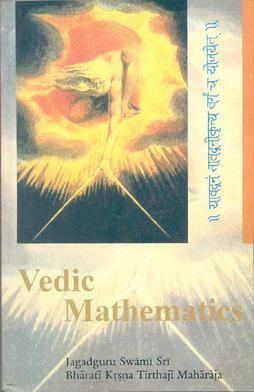8 /10 1 Votes
Language English ISBN 978-8120801646 Publisher Motilal Banarsidass Country India | 4/5 Goodreads Publication date 1965 Originally published 1965 Subject Mental calculation OCLC 217058562 | |||||||||||||||||||||||||||||||||
 | ||||||||||||||||||||||||||||||||||
Similar Atharvaveda, Shulba Sutras, Vedic metaphysics, Līlāvatī, Rigveda | ||||||||||||||||||||||||||||||||||
Vedic Mathematics is a book written by the Indian Hindu priest Bharati Krishna Tirthaji and first published in 1965. It contains a list of mental calculation techniques claimed to be based on the Vedas. The mental calculation system mentioned in the book is also known by the same name or as "Vedic Maths". Its characterization as "Vedic" mathematics has been criticized by academics, who have also opposed its inclusion in the Indian school curriculum.
Contents
Publication history
Although the book was first published in 1965, Tirthaji had been propagating the techniques since much earlier, through lectures and classes. He wrote the book in 1957. It was published in 1965, five years after his death as 367 pages in forty chapters. Reprints were made in 1975 and 1978 with fewer typographical errors. Several reprints have been made since the 1990s.
Contents
The book contains sixteen sutras and fifteen sub-sutras, each of which lists a mental calculation technique. The sixteen sutras are as follows:
Criticism
Tirthaji claimed that he found the sutras after years of studying the Vedas, a set of sacred ancient Hindu scriptures. However, the Vedas do not contain any of the "Vedic mathematics" sutras. First, Tirthaji’s description of the mathematics as Vedic is most commonly criticised on the basis that, thus far, none of the sūtras can be found in any extant Vedic literature (Williams, 2000). When challenged by Professor K.S. Shukla to point out the sutras in question in the Parishishta of the Atharvaveda, Shukla reported that the Tirthaji said the sixteen sutras were not included in standard editions of the Parishishta and that they occurred in his own Parishishta and not any other.
Professor Vasudeva Saran Agrawala, the editor of the first edition of Tirthaji's book, notes that there is no evidence that the sutras are "Vedic", as such, in their origin. Similarly, S. G. Dani of IIT Bombay points out that the contents of the book have "practically nothing in common" with the mathematics of the Vedic period or even with subsequent developments in Indian mathematics. For example, multiple techniques in the book involve the use of decimal fractions, which were not known during the Vedic times: even the works of later mathematicians such as Aryabhata, Brahmagupta and Bhaskara do not contain any decimal fractions. He contends that Tirthaji liberally interpreted three-word Sanskrit phrases to associate them with arithmetic.
Tirthaji's claim that the sutras are relevant to advanced mathematical techniques such as successive differentiation or analytical conics have also been dismissed by Dani. He terms "ludicrous" Tirthaji's claim that "there is no part of mathematics, pure or applied, which is beyond their jurisdiction". He also points out that while Tirthaji's methods were not unique, they may have been invented by him independently, as Tirthaji held an MA in mathematics. Similar systems include the Trachtenberg system or the techniques mentioned in Lester Meyers's 1947 book High-speed Mathematics. Alex Bellos points out that several of the calculation tricks can also be found in certain European treatises on calculation from the early Modern period.
Use in schools
The book was previously included in the school syllabus of Madhya Pradesh and Uttar Pradesh. Some schools and organizations run by Hindu nationalist groups, including those outside India, have also included Tirthaji's techniques in their curriculum. The Hindu nationalists have also made several attempts to have Tirthaji's "Vedic mathematics" system included in the Indian school curriculum via the NCERT books.
A number of academics and mathematicians have opposed these attempts on the basis that the techniques mentioned in the book are simply arithmetic tricks, and not mathematics. They also pointed out that the term "Vedic" mathematics is incorrect, and there are other texts that can be used to teach a correct account of the Indian mathematics during the Vedic period. They also criticized the move as a saffronization attempt to promote religious majoritarianism.
Dani points out that while Tirthaji's system could be used as a teaching aid, there was a need to prevent the use of "public money and energy on its propagation, beyond the limited extent". He pointed out that the authentic Vedic studies had been neglected in India even as Tirthaji's system received support from several Government and private agencies.
Proponents of Vedic Mathematics however argue that the methods are not merely mathematical tricks and that there is an underlying psychology because the aphorisms describe personal approaches to problem-solving. As pedagogic tools, the methods are useful because they invite students to deal with strategies.
